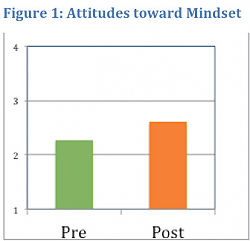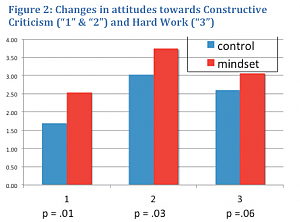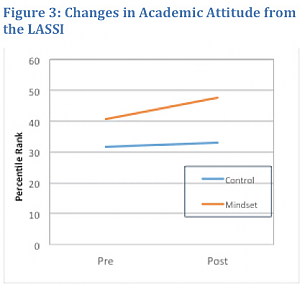By Manju Banerjee, Ph.D.; Rick Bryck, Ph.D.; and Susan Grabowski
Background
In recent years, increased attention has been directed towards predictors of students’ learning outcomes. While curriculum, pedagogy, and cognitive abilities continue to draw attention as important mediating factors in student success, students’ mindsets, that is, beliefs about themselves and their educational setting, have been shown to have a strong positive impact on outcomes (Yeager et al., 2013). The growth vs. fixed mindset paradigm, initially proposed by Carol Dweck in 2006, has spawned a rich research base and models of intervention for students in secondary and postsecondary settings. Simply described, students with a fixed mindset believe that their individual abilities and traits such as intelligence, personality, and skills are fixed parameters that are finite and unchangeable. Hence, any efforts to learn and improve are doomed to fail. Students with a growth mindset, on the other hand, subscribe to the notion that individual abilities and traits are malleable and can be changed. They believe in the power of effort and a positive definition of hard work. As reported by Yeager et al., “In this mindset, students respond more resiliently to challenges and show greater learning and achievement in the face of difficulty (p.2).”
Changing mindsets is part of a rapidly growing body of literature describing the value of social-psychological interventions on outcomes, including student learning (Blackwell et al., 2007; Farrington et al., 2012; Romero, Paunesku, & Dweck, 2011). For example, it has been shown that social-psychological interventions that mitigate concerns about negative stereotype improve students’ academic performance. A study with African American students demonstrated that when these students were asked to study new material under a threatening environment, they performed worse; even when presented with a non-threatening environment a week later, their performance did not improve (Rydell, Shiffrin, Boucher, Van Loo, & Rydell, 2010). Taylor and Walton (in press), as reported in Yeager et al. (2013), found that value-affirmation could undo the detrimental effects of stereotype threat. In fact, when provided with a value-affirming intervention, African American students learned more despite negative stereotype threat. Yeager et al. (2013) note that, “The results suggest that one way a value-affirmation intervention may improve long-term academic outcomes is by helping students acquire the building blocks of academic skills and knowledge needed to perform well in subsequent academic settings (p. 286).”
When employing psychological interventions, it is of critical importance to deliver psychological interventions at key educational junctures within a student’s learning trajectory. These key educational junctures may be at the beginning of an academic year (Cohen et al., 2006; Cohen et al., 2009), during transition from one school to a new school (Walton & Cohen, 2007, 2011; Wilson & Linville, 1982, 1985), or before taking a high stakes exam (Papay, Murnane, & Willett, 2010). The importance of timing of the intervention suggests that the earlier a value-affirming intervention is provided, the more it improves students’ grades (Cook, Purdie-Vaughns, Garcia, & Cohen, 2011).
There is no doubt that transition to college is a critical educational juncture. Many students with learning disabilities and other learning difficulties come to college with a predisposition to a fixed mindset. Often, past experiences have convinced them that they are incapable of academic success or are simply “not smart.”
Research Project
Rising high school juniors and seniors are a prime audience for intervention based on the changing mindset paradigm. As such, we piloted a research study with this population this past year as part of Landmark College’s High School Summer Program (HSSP).
Method
The Mindset intervention was embedded within the standard curriculum of the HSSP and consisted of (1) a series of short videos on neuroplasticity and understanding mindset, followed by (2) teacher-led discussions and writing, and (3) student engagement in short vignettes (case study group discussions) anchored in changing students’ perceptions of “hard work” and their attitudes towards “constructive criticism.” Research staff provided teacher orientation to the two teachers delivering the intervention curriculum.
Participants
Students in the HSSP program struggle with some aspect of academics and are taught skills and strategies to help prepare them for collegiate-level work. Half of the students received this “enhanced” mindset curriculum (n = 35), while the other half received curriculum as usual (n = 36).
Research instruments
Students in both groups were given a series of self-report surveys, both at the beginning and end of the HSSP. Surveys focused on mindset (their attitudes towards their own intelligence and abilities; 11 items), hard work (6 items), constructive criticism (6 items), and the standardized Learning and Study Strategies Inventory (LASSI) (76 items).
The overarching question this project sought to address was:
Does the implementation of a mindset change intervention, incorporated within the HSSP curriculum at Landmark College, result in positive attitude toward learning among at-risk high school students?
Results
 One of the primary goals of the study was to determine its feasibility – that is, we hoped to demonstrate “proof of concept” of our project. Namely, we hoped to deliver the intervention with minimal disruption of the program and the curriculum of the HSSP. This included conducting some of the data collection outside of class time (including during students’ free time). We were very happy to report that out of the 75 students who consented to participate, we were able to collect both Pre and Post data from 95% of them.
One of the primary goals of the study was to determine its feasibility – that is, we hoped to demonstrate “proof of concept” of our project. Namely, we hoped to deliver the intervention with minimal disruption of the program and the curriculum of the HSSP. This included conducting some of the data collection outside of class time (including during students’ free time). We were very happy to report that out of the 75 students who consented to participate, we were able to collect both Pre and Post data from 95% of them.
Secondly, we were interested in the degree to which the HSSP, in general, might influence students’ mindsets. The program is intended to improve students’ preparation for college and college-level work, including their self-confidence. Therefore, we expected we might see some improvements in attitudes after conclusion of the program in both groups. At the Post collection, we did in fact see a change overall in their attitudes toward the malleability of intelligence. As shown in Figure 1, there was a higher level of disagreement that IQ cannot change overall at the conclusion of the program. In other words, students in the program, as a whole, shifted their attitude towards a growth mindset.
 Thirdly, and most critically, we looked at attitude differences between the groups. The mindset intervention group, compared to the control group, showed improvement on attitudes towards both constructive criticism and hard work at Post test. As reflected in Figure 2, we see higher scores for the Mindset group (shown in red) vs. the Control group (shown in blue) for two items related to constructive criticism (labeled 1 and 2 in the figure). For example, intervention students were in higher agreement with the statement: “I have certain academic weaknesses which I can do nothing about, and teachers should understand that before being critical” (reverse scored), labeled “1” in Figure 2. Similarly, they agreed more with the statement: “I talk to my teachers afterwards about my test or assignment, if I get a poor grade” (“2” in Figure 2). The Mindset group also agreed more with the following item related to hard work: “I usually spend hours on a homework assignment until I feel it is the best I can do” (“3” in Figure 2). All three of these changes were significant, when compared with paired t-tests, p < .05 in all three cases.
Thirdly, and most critically, we looked at attitude differences between the groups. The mindset intervention group, compared to the control group, showed improvement on attitudes towards both constructive criticism and hard work at Post test. As reflected in Figure 2, we see higher scores for the Mindset group (shown in red) vs. the Control group (shown in blue) for two items related to constructive criticism (labeled 1 and 2 in the figure). For example, intervention students were in higher agreement with the statement: “I have certain academic weaknesses which I can do nothing about, and teachers should understand that before being critical” (reverse scored), labeled “1” in Figure 2. Similarly, they agreed more with the statement: “I talk to my teachers afterwards about my test or assignment, if I get a poor grade” (“2” in Figure 2). The Mindset group also agreed more with the following item related to hard work: “I usually spend hours on a homework assignment until I feel it is the best I can do” (“3” in Figure 2). All three of these changes were significant, when compared with paired t-tests, p < .05 in all three cases.
Improvements were also seen on a scale of the LASSI measuring their “Attitude” – specifically their attitudes toward and interest in college and academic success. This scale examines how useful their approach to college and academics is for helping them get their work done and succeeding in college. Low scores may reflect students not believing college is relevant to them or important, or that it does not relate to their future life goals. Some example items that make up this scale are as follows: “I have a positive attitude about attending my classes,” “I only study the subjects I like,” “I feel confused and undecided as to what my educational goals should be.”
 As we can see in Figure 3., students in the Mindset condition had higher scores at the Post assessment— their percentile scores were 48% compared to 32% for controls. This difference was significant at the p = .04 level (the smaller difference between the two groups at Pre test was not significant).
As we can see in Figure 3., students in the Mindset condition had higher scores at the Post assessment— their percentile scores were 48% compared to 32% for controls. This difference was significant at the p = .04 level (the smaller difference between the two groups at Pre test was not significant).
Results from the pilot study were highly encouraging. To quickly recap, we were able to 1) demonstrate feasibility of implementing a mindset intervention within the context of existing curriculum, 2) the results were consistent with an improvement in mindset overall, and 3) we found improvements specific to the intervention group, such that their beliefs about hard work, constructive criticism and attitudes towards academics were improved. We hope to conduct more research with a larger group of students, including students enrolled at Landmark College, to extend and replicate these effects with college students who learn differently.
More information and resources
- Mindset: The New Psychology of Success by Carol Dweck (2006)
- PERTS (Project for Education Research That Scales) Center at Stanford University – https://www.perts.net/resources
- Includes a Web applet that allows you to easily assess your students’ mindsets
References
Blackwell, L. A., Trzesniewski, K. H., & Dweck, C. S. (2007). Implicit Theories of intelligence and achievement across the junior high school transition: A longitudinal study and an intervention. Child Development, 78, 246–263.
Cohen, G.L., Garcia, J., Apfel, N., & Master, A. (2006). Reducing the racial achievement gap: A social-psychological intervention. Science, 313, 1307-1310.
Cohen, G.L., Garcia, J., Purdie-Vaughns, V. Apfel, H., & Brzustoski, P. (2009). Recursive processes in self- affirmation: Intervention to close the minority gap. Science, 324, 400-403.
Cook, J., Purdie-Vaughns, V., Garcia, J., & Cohen, G. (2011, April). Longitudinal impact of a values affirmation of its timing on minority students’ belonging and performance in middle school. Presentation at the biennial meeting for the Society for Research in Child Development, Montreal, Canada.
Dweck, C.S. (2006). Mindset: The new psychology of success. New York: Random House Publishing Group.
Farrington, C. A., Roderick, M., Allensworth, E., Nagaoka, J., Keyes, T. S., Johnson, D. W., & Beechum, N. O. (2012). Teaching adolescents to become learners. The role of noncognitive factors in shaping school performance: A critical literature review. Chicago, IL: University of Chicago Consortium on Chicago School Research.
Papay, J., Murnane, R., & Willett, J. (2010). The consequences of high school exit examination for low performing urban students: Evidence from Massachusetts. Educational Evaluation and Policy Analysis, 32, 5 – 23.
Romero, C., Paunesku, D., & Dweck, C.S. (2011, April). Brainology in the classroom: An online growth mindset intervention affects GPA, conduct and implicit theories. Poster presented at the biennial meeting for the Society for Research in Child Development, Montreal, Canada.
Rydell, R. J., Shiffrin, R., Boucher, K. L., Van Loo, K., & Rydell, M. T. (2010). Stereotype threat prevents perceptual learning. Proceedings of the National Academy of Sciences (USA), 107, 14042-14047.
Taylor, V.J., & Walton, G. (2011). Stereotype threat undermines academic learning. Personality and Social Psychology Bulletin, 37, 1055 – 1067.
Walton, G.M. (2014). The new science of wise psychological interventions. General Directions in Psychological Sciences, 23(1), 73-82.
Walton, G.M. & Cohen, G.L. (2007). A question of belonging: Race, social fit, and achievement. Journal of Personality and Social Psychology, 92, 82-96.
Walton, G.M. & Cohen, G.L. (2011). A brief social-belonging intervention improves academic and health outcomes among minority students. Science, 331, 1447-1451.
Wilson, T.D. & Linville, P.W. (1982). Improving the academic performance of college freshmen: Attribution theory revisited. Journal of Personality and Social Psychology, 42, 367-376.
Wilson, T.D. & Linville, P.W. (1985). Improving the performance of college freshmen with attributional techniques. Journal of Personality and Social Psychology, 49, 287-293.
Yeager, D.S., Paunesku, D., Walton, G.M. & Dweck, C.S. (2013). How can we instill productive mindsets at scale? A review of the evidence and an initial R&D agenda. A white paper prepared for the white house meeting on Excellence in Education: The importance of Academic Mindsets. Retrieved March 12, 2015 from https://web.stanford.edu/~gwalton/home/Welcome_files/YeagerPauneskuWaltonDweck%20-%20White%20House%20R%26D%20agenda%20-%205-9-13.pdf
Yeager, D.S., Trzesniewski, K., & Dweck, C.S. (2013). An implicit theories of personality intervention reduces adolescent aggression in response to victimization and exclusion. Child Development, 84, 970 -988.